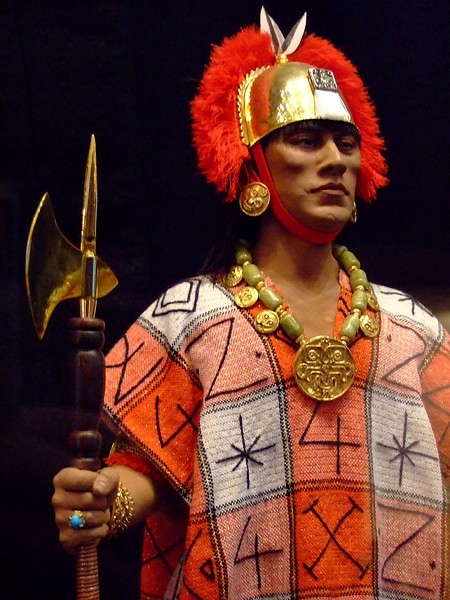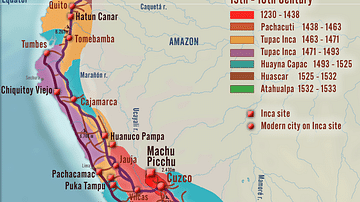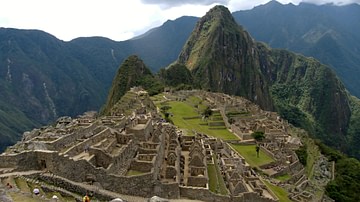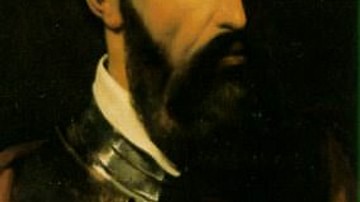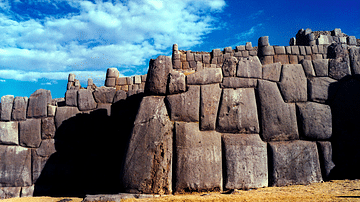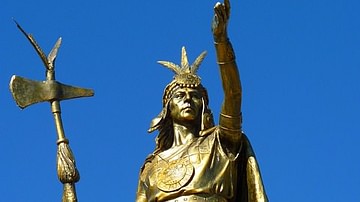
Atahualpa (Atawallpa) was the last ruler of the Inca Empire. He reigned from 1532 until his capture and execution by the invading Spanish forces led by Francisco Pizarro in 1533. The troubled Incas had suffered six years of damaging civil war and Atahualpa was only just enjoying his ascendancy to the throne when the Spanish arrived to turn the Inca world upside down.
Further weakened by European-introduced diseases, which wiped out millions, the Incas could do nothing against the better-armed invaders, even if there were only 168 of them. The Conquistadors were utterly ruthless and they would stop at nothing to gain the fabulous riches of the Americas' largest-ever empire.
Civil War & Succession
Atahualpa's father Wayna Qhapaq died in 1528 of smallpox, the most distinguished victim of the epidemic of European diseases which had spread from central America even faster than the foreign invaders themselves could manage. This epidemic killed a staggering 65-90% of the native population. When Wayna Qhapaq died without choosing a second heir (his first choice Ninan Cuyuchi also died of smallpox) Atahualpa battled for the throne with his half-brother Waskar (or Huascar) in a hugely damaging civil war which the Spanish would be only too glad to take advantage of when they arrived on Inca territory in 1532. Atahualpa was based in the northern capital at Quito while Waskar was at the Inca capital at Cuzco. After diplomatic relations soured between the two brothers, open warfare broke out in the north. There followed a series of battles between the Inca nobility which was costly to both sides until, after six years of fighting, Atahualpa finally prevailed.
By the time Spanish arrived, Atahualpa had managed to capture Waskar but the factions which had deeply split the empire remained. Waskar was imprisoned and his kin-group was killed, as were those who had supported him. Atahualpa even killed historians and destroyed the Inca quipu records. This was to be a total renewal, what the Incas called a pachakuti or 'turning over of time and space', an epoch-changing event which the Incas believed periodically occurred through the ages. What Atahualpa did not know was that another pachakuti was less than a year away, and this time he would be its victim.
Atahualpa's reign may have been brief but, as the Sapa ('Unique') Inca, he lived a life of extreme luxury. Drinking from gold cups, wearing silver-soled sandals and treated as a manifestation of the Sun god Inti on earth, Atahualpa was the head of the largest and richest empire the Americas had ever seen. His taste for opulence was chronicled by the Spanish who said that he once ordered a cloak made only from bat skins. As the Inca king and member of the royal blood line, he had the right to wear even more gold jewellery than the already over-laden nobility. His regalia included a feather headband (Ilauto), a golden mace (champi), and king-size golden ear-spools. The monarch travelled on a gold and silver litter further embellished with parrot feathers. He was fed food by a servant, and anything the royal person touched was collected and burnt in an annual ceremony to ward off witchcraft. If ever there was a pampered ruler it was the Sapa Inca of ancient Peru.
Pizarro Arrives
On Friday, 15th of November, 1532 the 168-man force of Spaniards led by Francisco Pizarro approached the Inca town of Cajamarca in the highlands of Peru. Pizzaro sent word that he wished to meet the Inca king, there enjoying the local springs and basking in his recent victory over Waskar. Atahualpa agreed to finally meet the much-rumoured bearded white men who were known to have been fighting their way from the coast for some time. Confidently surrounded by his 80,000 strong army Atahualpa seems not to have seen any threat from such a small enemy force and he made Pizarro wait until the next day. Then, seated on a low wooden throne and accompanied by all his wives and nobles, the Inca ruler finally came face to face with these curious visitors from another world.
Atahualpa is Captured
The first formal meeting between Pizarro and Atahualpa involved a few speeches, a drink together while they watched some Spanish horsemanship and not much else. Both sides went away planning to capture or kill the other party at the first available opportunity. The very next day Pizarro, using the conveniently labyrinth-like architecture of the Inca town to his advantage, set his men in ambush to await Atahualpa's arrival in the main square. When the royal troop arrived Pizarro fired his small canons and then his men, wearing armour, attacked on horseback.
In the ensuing battle, where firearms were mismatched against spears, arrows, slings, and clubs, 7,000 Incas were killed against zero Spanish losses. Atahualpa was hit a blow on the head and captured alive. Either held for ransom by Pizarro or even offering a ransom himself, Atahualpa's safe return to his people would only happen if a room measuring 6.2 x 4.8 metres were filled with all the treasures the Incas could provide up to a height of 2.5 m. This was done and the chamber was piled high with gold objects from jewellery to idols. The room was then filled twice again with silver objects. The whole task took eight months and the value today of the accumulated treasures would have been well over $50 million. Meanwhile, Atahualpa continued to run his empire from captivity and Pizarro sent exploratory expeditions to Cuzco and awaited reinforcements from Panama. Then, having got his ransom, Pizarro summarily tried and executed Atahualpa anyway, on the 26th of July 1533. The Inca king was originally sentenced to death by burning at the stake but, after the monarch agreed to be baptized, this was commuted to death by strangulation.
Some of Pizarro's men thought this was the worst possible response but the wily Spanish leader had seen just how subservient the Incas were to their king, even when he was held captive by the enemy. As one Miguel de Estete described the king receiving visitors during his captivity,
When they arrived before him, they did him great reverence, kissing his feet and hands. He received them without looking at them. It is remarkable to record the dignity of Atahualpa and the great obedience they all accorded him (D'Altroy, 93).
As a living god, Pizarro perhaps knew that only the king's death could bring about the total defeat of the Incas. Indeed, even in death the Inca king exerted an influence over his people for the severed head of Atahualpa gave birth to the enduring Inkarri legend. For the Incas believed that one day the head would grow a new body and their ruler would return, defeat the Spanish, and restore the natural order of things.
The Collapse of the Inca Empire
One of the reasons the Inca empire collapsed so swiftly following Atahualpa's death, perhaps in less than 40 years, was the fact that it was founded on, and maintained by, force, and the ruling Incas (only 40,000) were very often unpopular with their subjects (10,000,000 Andean people), especially in the northern territories. This was not least because the Incas extracted heavy tribute from conquered peoples – both in kind and labour - and loyal Inca subjects were forced on these communities to better integrate them into the empire. The Inca Empire, in fact, had still not reached a stage of consolidated maturity – it had only just reached its greatest extent a few years before.

It was a combination of factors then, a veritable perfect storm of rebellion, disease, and invasion, which brought the downfall of Atahualpa and the mighty Inca Empire in South America. In addition, the Inca mode of warfare was highly ritualized where such things as deceit, ambush, and subterfuge were unknown. Inca warriors were highly dependent on their officers, and if these fell in battle, a whole army could quickly collapse in panicked retreat. These factors and the superior weaponry of the Europeans meant the Incas had very little chance of defending a huge empire already difficult to manage.
Conclusion
Pizarro received criticism from the Spanish king Carlos I for treating a foreign sovereign so shabbily, and his attempts to install a puppet ruler – Thupa Wallpa, the younger brother of Waskar - failed to restore any sort of political order. The Spanish soon found out that the vast geographical spread of their new empire and its inherent difficulties in communication and control (even if their predecessors had built an excellent road system) meant that they faced the same management problems as the Incas. Added to this was the massive population decline following epidemics and communities still resentful of outside rule. For those local tribes, a change in rulers, unfortunately, brought no respite from a rapacious overlord, once again, eager to steal their wealth and impose on them a foreign religion.
